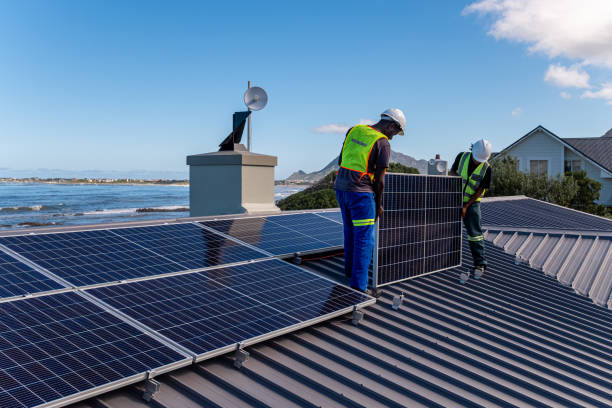
Choosing the right surveillance camera for your business can feel overwhelming. With so many options, finding one that fits your needs is critical.
This guide will break down features like video quality, storage, and durability to help you decide.
Keep reading—you don’t want to miss this!
Video Quality and Resolution
Clear video makes a huge difference in security. High-definition cameras capture fine details, even in tricky lighting.
Importance of 1080p, 2K, or 4K resolution
High-definition video matters in security cameras. A 1080p resolution provides clear footage, helping identify faces or license plates.
Moving up to 2K or 4K gives even sharper details, crucial for busy areas like offices or parking lots.
These resolutions make it easier to spot small objects and prevent misunderstandings during reviews.
For instance, a surveillance camera with a 4K resolution paired with motion tracking can record fine details at 30 fps. This level of detail helps businesses monitor activities day and night without losing quality.
It’s like having an extra set of sharp eyes guarding your space!
Low-light and night vision capabilities
A good surveillance camera works well, even in the dark. Night vision is critical for businesses running 24/7 or located in dimly lit areas.
Many cameras now come with infrared technology to provide clear footage after sunset.
Full-color night vision options go one step further, showing bright and detailed images even under minimal lighting.
Motion sensors boost security by detecting movement instantly. Pair this with tampering alarms for extra protection against threats. For devices like Nest Cam or Blink Outdoor, these features ensure a sharper eye on your property day and night.
Field of View and Coverage
A camera’s field of view can make or break your setup. Wide-angle options cover more space, saving you from buying extras.
Wide-angle lenses
Wide-angle lenses boost the field of view, covering more space in one shot. This is great for big areas like parking lots, warehouses, or offices.
They reduce blind spots and help you monitor multiple zones without needing extra cameras.
Using wide-angle surveillance cameras saves money and time. A single lens can do the job of two standard ones. Brands like Srihome often come with these lenses for better coverage.
Pan, tilt, and zoom functionality
PTZ cameras let you control the camera’s movement, so nothing escapes your view.
Pan lets it swivel side to side, tilt adjusts up and down, and zoom brings details closer. These features work together for better coverage and focus on important areas.
A 360-degree camera can sometimes replace PTZ cameras by offering a full field of view without moving parts.
But PTZ still shines when precise tracking is needed, like identifying faces or license plates in busy spaces.
Connectivity Options
Choose between wired or wireless based on your setup and needs. Check if the camera works well with your internet system, like Wi-Fi or Ethernet.
Wired vs. wireless cameras
When deciding between wired and wireless cameras for your business, the right choice can impact setup, performance, and reliability. Let’s break it down:
| Feature | Wired Cameras | Wireless Cameras |
| Image Quality | High-quality video, fewer signal interruptions | Good quality but depends on Wi-Fi strength |
| Installation | More complex, requires cables and planning | Simple, flexible, fewer tools required |
| Reliability | Stable connection, unaffected by Wi-Fi issues | Can drop connection during Wi-Fi outages |
| Power Source | Direct power source, no battery worries | Battery-powered or outlet-based, batteries need recharging |
| Coverage Area | Unlimited distance within cable reach | Restricted by Wi-Fi signal range |
| Cost | High upfront with cables and setup | Lower upfront, but costs may increase with cloud storage |
| Maintenance | Minimal upkeep once installed | Frequent checks for battery life and Wi-Fi issues |
Both types have strengths and flaws. Wired cameras provide sharper images, ideal for critical surveillance areas.
On the flip side, wireless cameras offer flexibility, handy for dynamic spaces.
Compatibility with Wi-Fi and Ethernet
Wireless cameras work well with Wi-Fi, offering flexibility in installation. They can connect to smart home systems like Google Nest or Apple HomeKit, making them a great choice for modern offices.
Ethernet compatibility is key for stable connections, especially in places with unreliable Wi-Fi.
Ethernet-powered IP cameras are common in businesses. They support high-quality streaming and advanced features like motion detection or facial recognition technology without lag.
This wired option also helps avoid interference from other devices like smartphones or wireless speakers nearby.
Storage Solutions
Storage matters to keep your footage safe. Decide between cloud services or local backups, based on what fits your business best.
Cloud storage options
Cloud storage offers flexibility and peace of mind. Businesses can access recordings remotely using Google Nest Hub, tablets, or iPhones.
Automatic updates keep security systems running smoothly without added effort.
Off-site backups protect data from theft or damage at the workplace.
Motion-triggered recording saves space by skipping empty footage. Platforms like Ring.com make managing these features simple and user-friendly.
It’s a modern solution that fits into smart home automation setups, working seamlessly with devices like Amazon Alexa or Apple TVs for extra convenience.
Local storage with SD cards or hard drives
SD cards and hard drives are dependable storage options for surveillance cameras. SD cards work best for small businesses or setups that need quick access to video clips.
They’re compact, affordable, and easy to replace if full.
A 128GB memory card can hold several days of footage in 1080p resolution.
Hard drives offer more space, making them ideal for larger operations. Some CCTV systems connect directly to a DVR or NVR that uses hard drives for continuous recording.
A 1TB hard drive may store weeks of high-quality footage without overwriting older files too soon.
Moving forward, consider how smart features enhance your system’s usability!
Smart Features and AI Integration
Smart features make cameras more than just watchers; they become problem-solvers. With AI, these cameras can think on their feet, spotting movement or even a face like a pro.
Motion detection and alerts
Motion detection keeps an eye out for movement, even when you can’t. Advanced cameras use PIR sensors to spot heat changes, reducing false alarms from pets or leaves.
Instant alerts hit your phone the moment a threat appears, so you act fast.
Some systems even trigger tampering alarms if someone tries to block or disable them. Pair these features with Google Home or SimpliSafe for smarter security setups.
Facial recognition and object tracking
Smart surveillance gets sharper with facial recognition. This feature helps identify people entering your business, boosting security and reducing risks.
It can match faces against stored data, catching repeat visitors or keeping track of flagged individuals.
For example, if a banned person enters, alerts get triggered instantly. Many cameras pair this tech with night-vision for 24/7 reliability.
Object tracking takes monitoring further by focusing on movement patterns. Cameras equipped with AI follow suspicious activity within their frame automatically.
Whether it’s someone loitering near smart doorbells or an unmarked vehicle in restricted zones, the camera records every action clearly.
This keeps you ahead of potential threats without constant manual supervision!
Durability and Environmental Suitability
A good surveillance camera should handle tough weather, like rain or heat. It also needs to resist damage from tampering or accidents.
Weatherproofing for outdoor use
Surveillance cameras outside face rain, dust, and temperature swings. A camera with strong weatherproofing handles harsh conditions well. Look for models rated IP65 or higher. This means they can resist heavy rain and debris.
Extreme cold or heat? Check if the device works between -4°F to 122°F.
Sturdy housing adds more protection against tough weather. Some brands offer extra shielding for sensitive parts like lenses or wires.
Don’t forget UV-resistant materials; they stop sunlight from wearing out the casing over time! Choose ones built smartly so your investment lasts longer outdoors.
Protection against tampering and vandalism
Strong housing prevents damage from vandals. Cameras with metal casings or anti-tamper screws are harder to break. Look for models with motion alarms that alert you if someone tampers with the device.
Choose cameras made for tough conditions. Outdoor ones should resist corrosion, dust, and water. This ensures they last longer in harsh spots like parking lots or busy streets. Up next: ease of installation and maintenance!
Ease of Installation and Maintenance
Setting up a surveillance camera shouldn’t feel like rocket science. Pick one that’s quick to install and simple to keep running smoothly over time.
Plug-and-play or professional installation
Plug-and-play cameras make setup easy. Just connect the device, and it’s ready to go.
This option saves time and works well for smaller businesses or offices. If you’re setting up in multiple locations, plug-and-play simplifies everything without extra costs.
Professional installation suits larger spaces or complex systems. Experts can hardwire devices, set angles, and configure software properly.
For outdoor setups with weatherproof cameras or anti-vandal features, an expert hand can be invaluable.
Software updates and maintenance requirements
Regular software updates keep your surveillance camera running smoothly. They fix bugs, improve security, and boost performance.
Without these updates, cameras may miss key features or become vulnerable to hacking.
Some systems give alerts for new downloads or auto-updates.
Maintenance is just as important. Routine check-ups help avoid issues like poor video quality or connection troubles. Professional support often covers troubleshooting and optimizing performance.
Moving on to durability and environmental suitability….
Conclusion
Picking the right surveillance camera is like finding the perfect tool for a job. You want clear footage, wide coverage, and smart features to keep your business secure.
Choose cameras that fit your needs today but can grow with you tomorrow.
A good system protects what matters while staying simple to use. Don’t cut corners—your business deserves the best protection it can get!
FAQs
1. What features should I prioritize in a high-quality surveillance camera for businesses?
Look for cameras with clear resolution, good lumens for low-light areas, and reliable networking capabilities. Video doorbells can also be helpful for entry points.
2. Can surveillance cameras integrate with other home appliances or systems?
Yes, many modern cameras work well with smart bulbs, sound systems, and even home theatre systems to create a connected environment.
3. Are there specific storage options I should consider?
Memory cards are essential if you want local storage. For larger setups, desktops or laptops can store footage over networks efficiently.
4. How does lighting affect the performance of a business surveillance camera?
Low lumens make it hard to capture details in dim spaces like bedrooms or warehouses. Cameras designed for low light perform better under such conditions.
5. Should I choose wired or wireless connectivity for my business setup?
It depends on your needs—wired setups offer stable connections through devices like printers or scanners, while wireless works seamlessly with mobile phones and tablets like Androids or Apple iPads.
6. Can these cameras detect more than just motion?
Some advanced models come equipped to detect smoke alarms or unusual sounds using integrated microphones—adding an extra layer of security beyond video recording alone!



